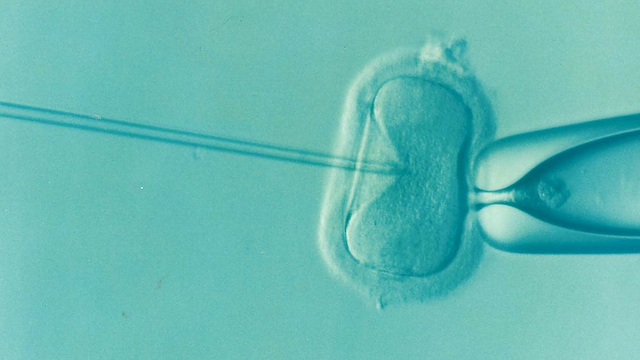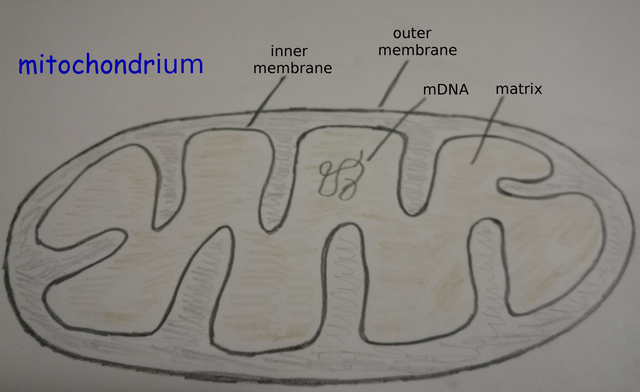
Image source: pixabay.
Today I would like to write about possible treatments to address hereditary mitochondrial diseases. The consequence of these medical methods are babies whose cells contain genes of three parents.
In meiosis gametes (egg cells and sperms) are built
At first a short repetition of some basic knowledge: The nucleuses of human somatic cells contain 23 twice = 46 chromosomes, or to be more exact: once the different chromosomes 1 to 23 from the mother plus once the homologous 1 to 23 ones from the father. These chromosomes consist of chromatin, a mix of proteins and DNA. The DNA comprises the genes which contain the necessary information to build the polypeptides of which consist our cells (and therefore also our bodies).
However that is different in case of gametes. When they are built, the number of chromosomes per cell decreases in the meiosis, a process of two divisions[1]:
- In the first one the number of chromosomes becomes reduced so that in every resulting cell there is only one set of chromosomes (1 to 23) left. The cells have changed from being diploid to haploid. (How many of the chromosomes in one of these cells stem from the mother and how many come from the father varies coincidentally.)
- In the second one the sister-chromatids of which every chromosome still consists are separated (similar like it happens during the mitosis of somatic cells). As a result of meiosis female and male gametes (egg cells and sperms) contain only 23 chromosomes.
Later, when a sperm mets an ovum they fuse so that the resulting start cell of a new human life (the zygote) comprises 23 + 23 = 46 chromosomes again.
Not all of our genes are located in the nucleus
Maybe not as well known as the above is the fact that not all of our genes are located in the cell nucleuses.
Within the highly complex process of the cellular respiration[2] cell organelles called mitochondria play a very important role. We segment this process into four main steps (who isn't interested in these biochemical details should continue to read after step 4):
-
Glycolysis: glucose is split into pyruvate:
C6H12O6 + 2 NAD+ + 2 ADP + 2 (P) --------> 2 CH3∙CO∙COO- + 2 NADH/H+ + 2 ATP
(Dissimilation need not to start with glucose. Energy can also be obtained from other macromolecules, for example other carbohydrates or triglycerides.)
-
Oxidative decarboxylation of pyruvate: CO2 is eliminated from pyruvate (and will be exhaled later); the remaining acetyl-CoA enters into the citric acid cycle (step 3):
2 CH3∙CO∙COO- + 2 CoA-SH + 2 NAD+ --------> 2 CH3∙CO~S-CoA + 2 NADH/H+ + 2 CO2
-
Citrate cycle: in a very complex process which could easily fill an own article and whose first product citrate is regenerated again and again, further CO2 is split off. The originating reducing equivalents NADH/H+ and FADH2 are necessary for the last step of the process:
2 CH3∙CO~S-CoA + 6 NAD+ + 2 FAD + 2 ADP + 2 (P) + 6 H2O --------> 2 HS-CoA + 6 NADH/H+ + 2 FADH2 + 2 ATP + 4 CO2
-
Oxidative phosphorylation: NADH/H+ and FADH2 are getting oxidized. Their lost electrons wander through a chain of enzyme complexes along the inner mitochondrial membrane where they lose energy. This energy is used to build a gradient of H+-ions between the two sides of the membrane. Finally another enzyme (ATP synthase) helps to discharge the gradient and the released energy is utilized to build ATP (adenosine triphosphate) from ADP (adenosine diphosphate).
10 NADH/H+ + 2 FADH2 + 32 ADP + 32 (P) + 6 O2 --------> 12 H2O + 10 NAD+ + 2 FAD + 32 ATP
The summation of the above leads to the final equation of cellular respiration:
C6H12O6 + 6 O2 + 36 ADP + 36 (P) --------> 6 H2O + 6 CO2 + 36 ATP (∆G ≈ - 2880 kJ / mole C6H12O6)
(The exact amount of gained ATP varies depending on the organism. Also some sources like Wikipedia put GDP/GTP into the equation of the citrate cycle instead of ADP/ATP but this GTP, guanosine triphosphate, often functions as intermediate product which serves to phosphorylate ADP to ATP later. Finally in my equations partly the number of H2O moles differs from my given Wikipedia source because otherwise the sum of all equations wouldn't fit with the end result.)
Three of the four steps of the cellular respiration take place in the mitochondria: step 2 and 3 in the mitochondrial matrix (space within the inner membrane) and step 4 in the chain of enzyme complexes along the inner mitochondrial membrane. The end product ATP delivers the energy for all processes within our metabolism, we need it when we speak, move or think. While I write this article a vast number of ATP molecules are dissipated into ADP in my cells and therefore I urgently need my mitochondria to renew it. :) Because of their important task to provide energy to the cells mitochondria are also called the "power plants of the cells".
|
The drawing of a mitochondrium on the right side shows that I may have other talents but to sketch is not one of them. :)
The inner membrane of this organelle is pushed in to enlarge the surface for the enzymes of the oxidative phosphorylation (similar like the cleavage of the cerebral cortex extends its surface as well). |

|
Mitochondria are not only of essential importance for our metabolism but at the same time they amaze with a highly surprising feature: They contain their own DNA (mDNA[3]) and genes!
Endosymbiotic theory: mitochondria have been independent organisms
What could be the reason for these mitochondrial genes? The endosymbiotic theory suggests that eukaryotic cells (and as a consequence finally also organisms like us) developed through symbiosis of different prokaryotic predecessor organisms: some chemo- or phototrophic bacteria have been 'eaten' (phagocytised) from other prokaryotes. But instead of being digested they continued to live. Within the process of evolution finally these endosymbionts have become cell organelles like for example our mitochondria. Knowing their origin as former independent organisms it may be less surprising that mitochondria have their own genes ...
Recent phylogenetic studies point to the direction that the 'host' that acquired mitochondria was an archaeon. These organisms were dependent on hydrogen which could be delivered from the incorporated mitochondria.[4], [5]
Hereditary mitochondrial diseases
As these cell organelles are responsible to provide the necessary energy for our metabolism it isn't surprising that mitochondrial diseases[6] cause symptoms like massive weakness and tiredness. Inherited mitochondrial diseases (to distinguish from acquired ones) are caused by mutations of genes which are responsible for structure and metabolism of mitochondria. Most affected are organs/structures like for example the heart and other muscles as well as the central nervous system including the brain because they consume and need very much energy. There are many different kinds of mitochondrial diseases (you can find some examples and descriptions of their symptoms in the article "Hofmann, S. and Bauer, M. F. 2006. Mitochondrial Disorders. eLS."[7]).
Mitochondria in our cells stem from the mother
Important for the understanding of mitochondrial diseases is the fact that apart from rare exceptions[8] mitochondria in our cells stem from the mother. It is not completely clear yet, why after fertilization of an egg cell by a sperm the mitochondria of the sperm normally don't survive. It is true that many of its mitchondria are located in a part of the tail (flagellum) of the sperm where they produce the necessary 'driving power'. While the sperm enters the ovum most of the time it loses the tail. But not all mitochondria are in the tail and in addition it is possible that the tail enters the egg cell as well. So what happens with the male mitochondria? An international team of scientists found out that in the sperms of a roundworm species (Caenorhabditis elegans) mitochondria seem to execute a self-destruction mechanism: a gene called CPS-6 is getting activated to produce an enzyme which destroys (as a mitochondrial endonuclease) the inner membrane of the organelles.[9]
Based on this discovery it can be assumed that it had a positive evolutionary effect to eliminate male mitochondria in the process of fertilization. One speculation is that mitochondria need to work so hard while the sperm tries to reach the ovum that they become kind of 'overworked'.[10]
Medical method to address hereditary mitochondrial diseases
For a rather long time there was nothing one could do against inherited mitochondrial deseases. However this has changed since knowledge about genetical coherences has increased and technology advanced. A new medical method gives women with affected mitochondria new hope. The 'recipe' of the method is as follows (I think I saw so many recipes here in Steemit that this word occurred to me now :-) ):
- Take egg cells from the concerned woman and extract intact nucleuses.
- Take egg cells with functioning mitochondria from a healthy woman and extract the nucleuses as well.
- Put intact nucleuses from the eggs of the affected woman into the denucleated eggs of the other woman (which still contain intact mitochondria).
- Don't forget the father now! :) Fertilize the eggs with sperms of the father.
- 'Plant' the embryo into the uterus of any woman ...
The result would be a baby with three parents: one father and two mothers.[11] Even if I described it like a very simple 'recipe' of course all these has to be done under sterile conditions in very modern equipped laboratories.
Science fiction only? Not at all: in April 2016 in Mexico it did already happen. As scientists from the USA, Mexico and Great Britain report a boy was born after using this method of nucleus transfer from one egg cell into another one to address the Leigh syndrome.[12], [13]
Ethical discussion
The parents of the boy stem from Jordan, but this method is forbidden by law there, like in many other countries (for example also in the USA and Germany) as well. Therefore the operation took place in Mexico where it is allowed. In Germany for now it is prohibited to donate egg cells.
In Great Britain a similar procedure is already approved[14]: the difference is that in this case the nucleuses are extracted from already fertilized egg cells. Also an extracted nucleus of a healthy woman is already fertilized and will be thrown away. In the eyes of some critics of the method that means to kill a living creature.
Another question would be how a growing human feels when his parents tell him one day that there exists even one more mother?
What do you think about these here presented methods which on the one hand allow women with mitochondrial diseases to give birth to healthy babies which otherwise would suffer a lot or even die in a very early stage of life but on the other hand cause quite some ethical discussions?
Sources:
- http://www.nature.com/scitable/definition/meiosis-88
- https://de.wikipedia.org/wiki/Aerobe_Atmung
- https://web.archive.org/web/20150907140051/http://genome.wellcome.ac.uk/doc_WTD020876.html
- http://www.nature.com/articles/nmicrobiol201634
- http://www.wissenschaft.de/leben-umwelt/biologie/-/journal_content/56/12054/10937328/Wie-die-ersten-komplexen-Zellen-entstanden/
- https://de.wikipedia.org/wiki/Mitochondriopathie
- http://onlinelibrary.wiley.com/doi/10.1038/npg.els.0005539/full
- http://www.nature.com/hdy/journal/v93/n4/full/6800572a.html
- http://science.sciencemag.org/content/353/6297/394
- https://www.nytimes.com/2016/06/24/science/mitochondrial-dna-mothers.html
- http://www.zeit.de/wissen/gesundheit/2016-09/drei-eltern-baby-gentechnik-befruchtung-mexiko-geburt-dna
- http://www.fertstert.org/article/S0015-0282(16)62670-5/abstract
- http://www.mgz-muenchen.de/erkrankungen/diagnose/leigh-leigh-like-syndrom.html
- http://www.zeit.de/wissen/gesundheit/2015-02/drei-eltern-baby-zustimmung-britisches-oberhaus
